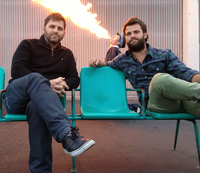Tuesday, March 11, 2014
How ZEFR Is Helping Hollywood And Brands Understand YouTube

Want to understand the world of YouTube? There's no better way than post thousands of pieces of content online and see what happens -- and realize that the tools weren't there to truly figure out what was happening. Venice-based Zefr (www.zefr.com) got its start in the content world--licensing movie clips and posting them online--but soon, figured out there was a whole different opportunity in developing software tools to understand exactly what was happening on YouTube. The firm now has $30M more in the bank--it just announced a big round lead by Institutional Venture Partners (IVP) with participation U.S. Venture Partners, Shasta Ventures, First Round Capital and Richmond Park Partners--so we thought it would be great to catch up with co-founders Rich Raddon and Zach James to hear more about what the company is working on now.
Thanks for the time today. Tell us a little bit more about where ZEFR's main focus is nowadays?

Rich Raddon: As you know, we originally started out as a different company, MovieClips, at the very beginning. We had gone out to all of the Hollywood studios, and licensed clip content, short segments of filmed. We published those out of our dot com, and we were also able to convince studios to allow us to publish them on channels on YouTube. Those channels still exist today, and get around 200 million views a month--we ended up becoming one of the largest movie networks for video on the web. But, what that really did, is it allowed us to use that network to incubate the software we are building now for YouTube.
Our first set of technology in the stack was around rights management, because, as we started uploading licensed content from the studios, we found out that many fans had figured out a way to upload those same scenes on their respective channels. We saw that fan activity, and were excited about it, and thought it was really cool. Up until that time, most of the studios had followed the "whack-a-mole", take-it-down approach. They were utilizing YouTube's tools to find content, and take it down--YouTube's ContentID. What we pioneered with the studios, is instead of taking all of that content down, we built additive technology which would find those uploads, harness it, claim it, monetize it, and also track all of the data coming from viewing of that content. That's what we call our rights ID or rights management software stack. That's when we rebranded to ZEFR.
Why the rebranding?
Rich Raddon: We did that, because we had been working with studios, and also knew music labels were really interested in monetizing that activity on YouTube. We started working with them, too, and realized there were more and more verticals this could be applied to. We rebranded as ZEFR when we released the rights management software.
Then, we took that same technology stack, and thought--what more can we do with this? There are 100 hours of video uploaded every sixty seconds to YouTube, and much of that video has to do with brands. Those are people making home videos, talking about brands, discussing brands, homages to brands, sometimes uploading commercials. But, more often than not, they're doing different kinds of activities around a brand. If an individual had a passion point with a brand, you wouldn't find any of that activity on a brand's actual social channels, and brands didn't have very good insight into what that activity was, and who those fans were. So, we built a piece of software, BrandID, which we launched into beta last fall, and where we're working with some great partners. The final piece we are working on, is software called ChannelID, focused on owned and operated channels. We have already licensed this out to great partners like SNL, and we have a great relationship with NASCAR, which helps them managed their owned media on YouTube. Last year, we bought Pipewave, which was providing ad serving into youTube, and we've repackaged that software to allow people to buy media very efficiently on YouTube, especially around the planning and operating phase of buying media, and targeting media against very specific content on YouTube.
So tell us about the new investors?
Zach Games: Rich and I were trying to build a big software company here in LA, and in order to that, you need people who are invested in the ecosystem. You don't want people who are myopically focused on just one area, like New York or San Francisco--we wanted best of breed software guys. In late stage, IVP is arguable the best, and they've been behind folks like Twitter and Dropbox. We wanted their late stage investing experience, and their experience in social software, which they have through Buddy Media and other companies they have invested in. Plus, they've invested in Los Angeles. They came to LA, and they've invested in companies like Honest Company and Snapchat, and a few others, hosted dinners for Los Angeles entrepreneurs, and they've made a serious investment in the community. That goes a long way. They've been coming here for two years, meeting with people here in Los Angeles, and we thought that we pretty cool.
Where was the turning point where you saw that focusing on the software--not the content--was the right place to be for ZEFR?
Rich Raddon: That's a really good question. When we first started with MovieClips and developing on YouTube, we already had a bunch of engineers, and had built out a dot com. We started looking at the documentations and APIs at YouTube, and saw then that there were lots of inaccuracies. Those APIs have since been rewritten, and there are now far more APIs available than the two or three years ago we started that development. But, that was a signal to us. There were at the time almost billion views a day on YouTube, and not even near the amount of views today, but we recognized that this was really the future of people consuming video on the internet. To our knowledge, at the time--and which we've found to be mostly true--is there's not a strong developer community on top of that, mostly because YouTube has focused on being such a great thing for the consumer space, that it's mostly media entrepreneurs attracted to the ecosystem. If you look at the history of companies who have been built on the YouTube platform, you'll see that most of them come from a traditional media background, using different media to distribute content. It felt to us, once we got on the platform, that it was a crowded space. And, it was getting more crowded, because for media entrepreneurs, it offers such an interesting new dynamic and way to distribute and monetize content.
So, we saw that everyone was going right--so we thought, let's look left, and develop software for the platform instead, because no one else was doing it. We had more and more enterprise clients interested, and our solutions addressed their needs. Plus, as we met with the YouTube engineers in those early day, they have a big goal to create a very robust platform. If you are looking to build a platform, you spend most of your time developing solutions for the average individual on the platform--not necessarily to address very specific needs of the enterprise clients on that platform. We recognized--because we were already working with the Hollywood studios, and had those relationships with those big enterprise clients, and were already developing software for them. We now literally have a 360 degree solution, covering owned, earned, and paid solutions through software now.
You mentioned the industry playing whack-a-mole earlier. From your perspective, where's the industry now on that kind of activity?
Rich Raddon: I think the industry is still in transition, but on the back end of that transition. I think most major media companies recognize that harnessing fan activity is a good thing, and not a bad thing. There are still some holdouts in each vertical by big media companies that don't want to embrace the new way of dynamically harnessing fan activity, because it just never existed before. Before, people couldn't just put a piece of your content online and upload it, and start collecting subscribers and views. That just didn't exist before YouTube. However, we're now seeing tremendous growth of media companies who are accepting that new dynamic.
Zach James: From the fan perspective, nothing has changed. However, it's a whole new day for brands. One thing we like to say, is fans are becoming fans of fans. You can have a Harry Potter franchise, and you'll find that there will be someone out there who loves Harry Potter, and will start generating fan stuff because they love Harry Potter so much. That applies to media, but that also applies to brands. For example, you might have a big fan of Revlon makeup, and they starts to get her own fans because she's talking so much about Revlon. That's the phenomenon we've unearthed, and we're starting to decipher those groups and sub-brand groups. As Rich says, media companies are starting to understand what these fans are doing is passion, not piracy Instead of playing whack-a mole, media companies are seeing the benefit of earned media. Now, brands are starting to see their own wave. Rich and I made a bet two years ago, working with media companies, that this would happen with brands. Media companies were saying at the time that their number one strategy to figure out was YouTube. Today, we hear from every brand that 2014 is the year they figure out YouTube. It's just a different wave with brands and media companies.
What' next for you guys?
Zach James: Number one is international expansion; two, is we'll continue to build out software tools for our brand offerings; and three, is we'll be adding cross platform tools, and continue to work with other social platforms around rights management and brand management.
Rich Raddon: If you look at our funding, what we're going to do is build out our engineering resources, and sales and marketing. We have software that is so compelling, and clients using it are really excited about. It's not only rights management, but software for earned and paid media for brands. We are now providing a 360 degree view of everything a brand would want on the platform. It's been just a rocketship, and this keeps on fueling the fire.
Thanks!